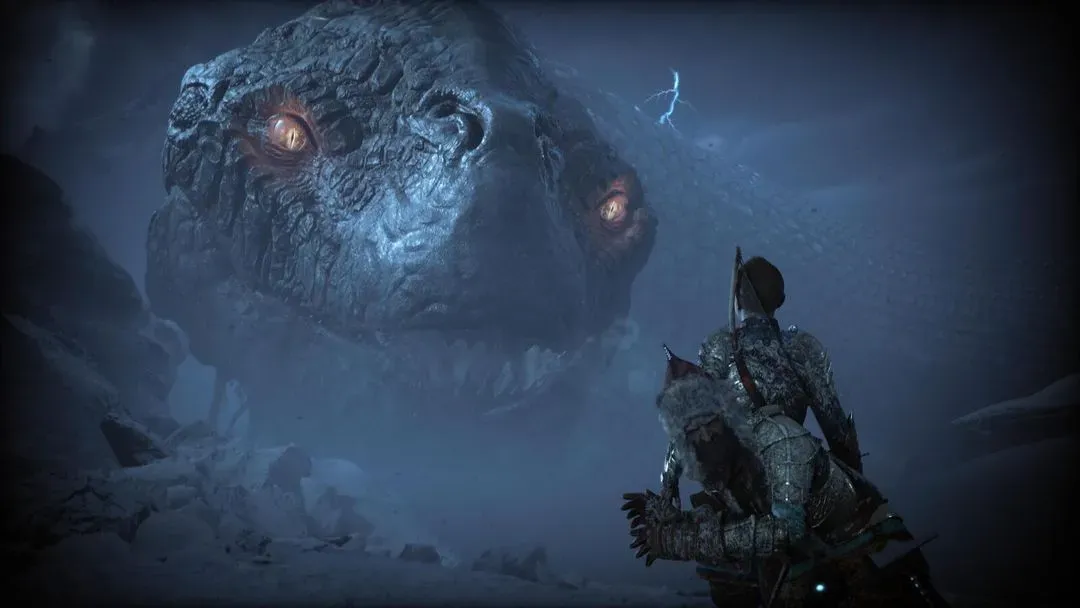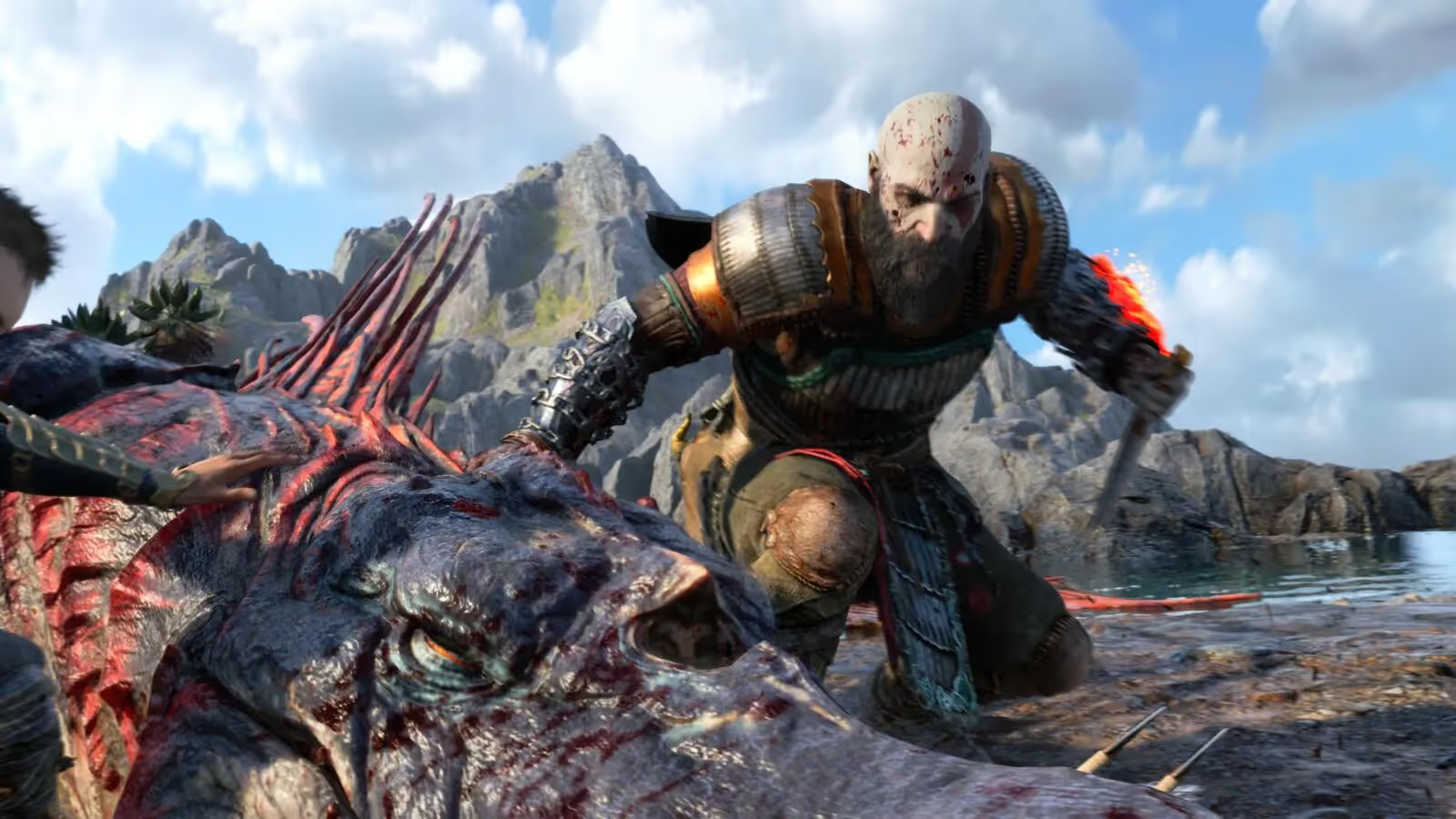PS5
PS4
Ceramicists, avert your eyes. Gaming’s most famous pot-smasher has returned to the PlayStation in triumphant style. If 2018’s God of War set the bar for AAA gaming — both in action-adventure gameplay and narrative — its sequel takes almost everything that came before and improves it, but with the trade-off being a game that feels a lot more sprawling and prone to bloat.
Ragnarok picks up a few years after Kratos and Atreus’ journey to scatter the ashes of Atreus’ mother. The remaining Norse gods, whom Kratos royally pissed off in the first game, are willing to let the pair be for their own reasons. Yet Atreus is intrigued about his giant name “Loki”, which he learned when he was a boy, and has been performing covert missions to uncover both the stories of the past and the future — in particular concerning Ragnarok, the almighty apocalyptic battle of the gods. It seems that all is not as prophesied, and he convinces Dad to help him bust Týr (Kratos’ Norse equivalent) out of prison to find out what the hell is happening.

Unlike many sequels, coming into Ragnarok without playing the first game will be doing yourself a disservice. Not least because God of War (2018) is so damn good, but also because there is a dense story here filled with callbacks and Easter eggs that would simply be wasted on a newbie. There is a recap from the main menu, but it serves more like a sizzle trailer for the first game rather than anything of substance. Do yourself a favour and grab a copy so you can fully appreciate the level of effort Santa Monica Studio have invested in the sequel.
Everything that made the first game’s combat brilliant is here, but it’s been amped up further in almost every aspect. Kratos’ weapons are juicier and the weapon trees allow for expansion to movesets that crackle with potential. Whether hurling your boomeranging Leviathan axe, swinging your disco whips, or amping up your amulet to add more attacks to all of your weapons, the combination of frost and fire provides dozens of combinations in combat that seamlessly segue, while your shield can be used to parry or block and open up counter-attacks that feel earned and satisfying. Improvements and upgrades to weapons, armour and skills are introduced at exactly the right pace, allowing you to appreciate each before deciding on a playstyle that you prefer, then switching it up as new toys and methods of dispatch become available. While in the first game I stuck mostly to the axe as it felt both more powerful and looked so damn cool to use, that novelty is gone and I found myself trying out new combos with the other weapons — although the element effect that each applies to enemies actively encourage you to switch as much as possible, and my word does it feel good. In some respects there are almost too many special moves and combos to pick up and memorise. You’ll stick with the ones you’re used to initially before specific enemies encourage you to make more use of the unlocked ones from your skill tree.

The main gripe from players about the first game was that three of the nine realms were inaccessible. This was harsh given that the main story alone took about twenty hours; it’s more likely that they simply wanted more. And by the Gods, have they got it here. The opening sequences set up the story of Fimbulwinter and its endless frosty chill as the precursor to Ragnarok itself, while there is a lovely nod to the first game’s hunting introduction. All nine realms are now accessible, and the familiar ones have been given a suitably sinister coating to emphasise the effect that the end of days may bring. These aren’t just window dressing either, but genuinely exciting and vast lands, filled with meaty sidequests outside the main story. This isn’t Assassin’s Creed-style busywork but emotionally riveting bonus chapters that flesh out the game’s story as well as providing hefty rewards of hacksilver, experience, equipment upgrades in the form of runes, and stats increases. That said, there is a counter-argument that most of the side quests are padding. Excellently produced padding, but padding nonetheless, given that it can all be revisited as post game content. It’s addictive to get caught up in a side quest to look for Freya’s wedding gifts or to help clear a poison-infested marsh of zombies, but each lengthy side quest detracts from the focus of the main story.

Many gamers will be fine with that. Front and centre is the father-son relationship, as with the first game. But where “boy” Atreus was a relative innocent who obliged Kratos willingly, here he’s a more independent youth coming to terms with powers he has no knowledge of. The balance is shifting and they can both feel it. Christopher Judge and Sunny Suljic return as the two leads, along with Alastair Duncan’s portrayal of Mimir, the severed talking head who acts as the game’s expository outlet (with a few too many exclamations of “Brother” this time around), soothing and entertaining with his gentle Scottish tone as the three protagonists flit between realms. In Ragnarok though, there are far more secondary characters to appreciate. While some return — such as Freya — the appearance from the outset of Odin (Richard Schiff) sets the tone for a unique take on the Norse pantheon. I would never have considered the West Wing’s spindly Toby Ziegler to be cast as the king of the Gods, but he absolutely nails it. And things only get better as more is discovered about the nature of Ragnarok itself.

The theme of destiny crackles through the game as Kratos and his son uncover more and more contradictory evidence about what has been foretold. The newly ebullient Atreus is only too keen to pull at threads, while his ever-cautious father is dragged along by his enthusiasm, with an eye on both their backs. The voice acting is often incredible. Every single one of the game’s co-stars imbues their character with purpose and feeling, from Freya’s rage to Thor’s arrogance, from Brok’s disgust to Sindri’s nervous humour. They only slip into phoned-in territory where your companions are commenting on the scenery or advising you of your next step. The verbal battles are often as brutal as the physical ones, and in the latter case it truly does feel like you’re playing a blockbuster. But where franchises like the MCU often feel sterile in their depiction of combat on screen, Ragnarok makes you feel every smashed pillar and shudder at every ripped-off limb. The cinematography is simply phenomenal, the animation utterly sublime. Even the simple task of walking around a roundhouse or having dinner within it demonstrates the immense effort that went into sound editing. Every creak of wood is captured perfectly, each delicate slide of a plate or clatter of a knife resonating in your ears exactly as you’d expect it to (and headphones come highly recommended).

Puzzles, a surprisingly fun part of God of War, are back in abundance and with shiny new layers. Reflecting stones provide angular conundrums for you to bounce your axe off, Atreus’ new sonic arrow skills allow you to shatter rocks susceptible to sound, and there are plenty of gears to grind and levers to crank. It’s a shame that the game has followed Horizon Forbidden West’s playbook in this regard though: you can barely spend a moment taking in a new puzzle before either Mimir or Atreus chime in with a possible solution. They aren’t quite as egregious as Aloy’s mutterings, and they usually don’t completely ruin the answer, but the interruptions certainly take a bit of the enjoyment out of trying to solve things yourself.

But in essence, there’s more of everything. Most of it is good. Some of it is repetitive. It’s a step above Horizon’s sequel in that the world is interesting to explore and based on mortals and gods that will be familiar to those with Norse mythology, but for every Thor and Heimdall for the Marvel crows, there is a Kvasir or an Angrboda for the hardcore. This feels like a kitchen sink approach some of the time; it’s the opposite issue to the 2018 game in that keeping track of who has relationships or is related to whom becomes a mind-bending exercise and one that many will discard in favour of lopping heads off serpents in creative ways.

Even the gameplay goes into overdrive as Ragnarok is no longer just Kratos’ story, but Atreus’, so this time around you’ll get to play as “Boy” a fair bit. While he does have a few nice moves, the nature of his ranged attack means that opponents are rarely as tough or exciting as those his Dad faces and, dare I say it, his sequences are occasionally dull — just a lot of mostly linear A to B travelling. The main quest where he rides a yak is gorgeous, but my goodness does it drag. It does have the benefit of making the boat sections (also returning, sadly) look comparatively fast-paced. Every time I was playing as Atreus, I found myself yearning to get back into the God of War’s boots and start smacking people with an axe. Other quirks include making the ravens even more infuriating to capture, introducing Týr as a cross between Eeyore and the member of a 90s grunge band, and the meta commentary (“My dad likes loot!” Atreus exclaims at one point), both of which threaten to pull you out of the generally po-faced ruminations on life, death, revenge and destiny. There are a lot of those, and Kratos and Mimir are happy to present them in multiple ways throughout your 40+ hour slog through the main story. Strap in.

Still, I can’t argue that I had an absolute blast with this sequel. It’s not the masterpiece that many publications have been touting it to be, and yes, it often feels like the same but more, but that “more” is still doing a lot of heavy lifting. There’s a more expansive RPG-lite system, codex entries that update as you discover more about foes, a far greater set of abilities for your companion and an interface which is a little less clunky than before. And that’s without even mentioning the treasure maps, favours, secrets, mini-bosses and puzzles you’ll stumble upon. If this is the end of Kratos’ foray into Norse territory, then it’s been mined for significantly more hacksilver than its predecessor and while it might strain under the weight of bloat at times, there’s no denying it’s a technical marvel to look at and play, a triple-A blockbuster in the truest sense.
You can subscribe to Jump Chat Roll on your favourite podcast players including:
Let us know in the comments if you enjoyed this podcast, and if there are any topics you'd like to hear us tackle in future episodes!



